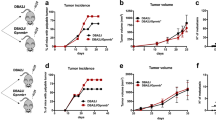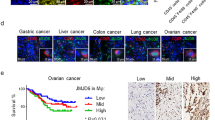Abstract
Response gene to complement 32 (RGC-32) is a cell cycle regulator involved in the proliferation, differentiation and migration of cells and has also been implicated in angiogenesis. Here we show that RGC-32 expression in macrophages is induced by IL-4 and reduced by LPS, indicating a link between RGC-32 expression and M2 polarization. We demonstrated that the increased expression of RGC-32 is characteristic of alternatively activated macrophages, in which this protein suppresses the production of pro-inflammatory cytokine IL-6 and promotes the production of the anti-inflammatory mediator TGF-β. Consistent with in vitro data, tumor-associated macrophages (TAMs) express high levels of RGC-32, and this expression is induced by tumor-derived ascitic fluid in an M-CSF- and/or IL-4-dependent manner. Collectively, these results establish RGC-32 as a marker for M2 macrophage polarization and indicate that this protein is a potential target for cancer immunotherapy, targeting tumor-associated macrophages.
This is a preview of subscription content, access via your institution
Access options
Subscribe to this journal
Receive 12 digital issues and online access to articles
$119.00 per year
only $9.92 per issue
Buy this article
- Purchase on Springer Link
- Instant access to full article PDF
Prices may be subject to local taxes which are calculated during checkout





Similar content being viewed by others
References
Auffray C, Sieweke MH, Geissmann F . Blood monocytes: development, heterogeneity, and relationship with dendritic cells. Annu Rev Immunol 2009; 27: 669–692.
Geissmann F, Manz MG, Jung S, Sieweke MH, Merad M, Ley K . Development of monocytes, macrophages, and dendritic cells. Science 2010; 327: 656–661.
Cohen HB, Mosser DM . Extrinsic and intrinsic control of macrophage inflammatory responses. J Leukoc Biol 2013; 94: 913–919.
Martinez FO, Gordon S, Locati M, Mantovani A . Transcriptional profiling of the human monocyte-to-macrophage differentiation and polarization: new molecules and patterns of gene expression. J Immunol 2006; 177: 7303–7311.
Locati M, Mantovani A, Sica A . Macrophage activation and polarization as an adaptive component of innate immunity. Adv Immunol 2013; 120: 163–184.
Mantovani A, Sica A, Sozzani S, Allavena P, Vecchi A, Locati M . The chemokine system in diverse forms of macrophage activation and polarization. Trends Immunol 2004; 25: 677–686.
Mills CD, Kincaid K, Alt JM, Heilman MJ, Hill AM . M-1/M-2 macrophages and the Th1/Th2 paradigm. J Immunol 2000; 164: 6166–6173.
Hao NB, Lu MH, Fan YH, Cao YL, Zhang ZR, Yang SM . Macrophages in tumor microenvironments and the progression of tumors. Clin Dev Immunol 2012; 2012: 948098.
Obeid E, Nanda R, Fu YX, Olopade OI . The role of tumor-associated macrophages in breast cancer progression (review). Int J Oncol 2013; 43: 5–12.
Menen RS, Hassanein MK, Momiyama M, Suetsugu A, Moossa AR, Hoffman RM et al. Tumor-educated macrophages promote tumor growth and peritoneal metastasis in an orthotopic nude mouse model of human pancreatic cancer. In Vivo 2012; 26: 565–569.
Allavena P, Sica A, Garlanda C, Mantovani A . The Yin–Yang of tumor-associated macrophages in neoplastic progression and immune surveillance. Immunol Rev 2008; 222: 155–161.
Santoni M, Massari F, Amantini C, Nabissi M, Maines F, Burattini L et al. Emerging role of tumor-associated macrophages as therapeutic targets in patients with metastatic renal cell carcinoma. Cancer Immunol Immunother 2013; 62: 1757–1768.
Solinas G, Germano G, Mantovani A, Allavena P . Tumor-associated macrophages (TAM) as major players of the cancer-related inflammation. J Leukoc Biol 2009; 86: 1065–1073.
Badea T, Niculescu F, Soane L, Fosbrink M, Sorana H, Rus V et al. RGC-32 increases p34CDC2 kinase activity and entry of aortic smooth muscle cells into S-phase. J Biol Chem 2002; 277: 502–508.
Schlick SN, Wood CD, Gunnell A, Webb HM, Khasnis S, Schepers A et al. Upregulation of the cell-cycle regulator RGC-32 in Epstein–Barr virus-immortalized cells. PLoS One 2011; 6: e28638.
An X, Jin Y, Guo H, Foo SY, Cully BL, Wu J et al. Response gene to complement 32, a novel hypoxia-regulated angiogenic inhibitor. Circulation 2009; 120: 617–627.
Huang WY, Li ZG, Rus H, Wang X, Jose PA, Chen SY . RGC-32 mediates transforming growth factor-beta-induced epithelial–mesenchymal transition in human renal proximal tubular cells. J Biol Chem 2009; 284: 9426–9432.
Wang JN, Shi N, Xie WB, Guo X, Chen SY . Response gene to complement 32 promotes vascular lesion formation through stimulation of smooth muscle cell proliferation and migration. Arterioscler Thromb Vasc Biol 2011; 31: e19–e26.
Guo X, Jose PA, Chen SY . Response gene to complement 32 interacts with Smad3 to promote epithelial–mesenchymal transition of human renal tubular cells. Am J Physiol Cell Physiol 2011; 300: C1415–1421.
Tanaka T, Takada H, Nomura A, Ohga S, Shibata R, Hara T . Distinct gene expression patterns of peripheral blood cells in hyper-IgE syndrome. Clin Exp Immunol 2005; 140: 524–531.
Tegla CA, Cudrici CD, Azimzadeh P, Singh AK, Trippe R 3rd, Khan A et al. Dual role of Response gene to complement-32 in multiple sclerosis. Exp Mol Pathol 2012; 94: 17–28.
Tjiu JW, Chen JS, Shun CT, Lin SJ, Liao YH, Chu CY et al. Tumor-associated macrophage-induced invasion and angiogenesis of human basal cell carcinoma cells by cyclooxygenase-2 induction. J Invest Dermatol 2009; 129: 1016–1025.
Bellora F, Castriconi R, Dondero A, Reggiardo G, Moretta L, Mantovani A et al. The interaction of human natural killer cells with either unpolarized or polarized macrophages results in different functional outcomes. Proc Natl Acad Sci USA 2010; 107: 21659–21664.
Puig-Kroger A, Sierra-Filardi E, Dominguez-Soto A, Samaniego R, Corcuera MT, Gomez-Aguado F et al. Folate receptor beta is expressed by tumor-associated macrophages and constitutes a marker for M2 anti-inflammatory/regulatory macrophages. Cancer Res 2009; 69: 9395–9403.
Shao Q, Ning H, Lv J, Liu Y, Zhao X, Ren G et al. Regulation of Th1/Th2 polarization by tissue inhibitor of metalloproteinase-3 via modulating dendritic cells. Blood 2012; 119: 4636–4644.
Zhang S, Yin J, Li X, Zhang J, Yue R, Diao Y et al. Jacarel hyperol A induced apoptosis in leukaemia cancer cell through inhibition the activity of Bcl-2 proteins. BMC Cancer 2014; 14: 689.
Daigneault M, Preston JA, Marriott HM, Whyte MK, Dockrell DH . The identification of markers of macrophage differentiation in PMA-stimulated THP-1 cells and monocyte-derived macrophages. PLoS One 2010; 5: e8668.
Tsuchiya S, Kobayashi Y, Goto Y, Okumura H, Nakae S, Konno T et al. Induction of maturation in cultured human monocytic leukemia cells by a phorbol diester. Cancer Res 1982; 42: 1530–1536.
Cahill CM, Rogers JT . Interleukin (IL) 1beta induction of IL-6 is mediated by a novel phosphatidylinositol 3-kinase-dependent AKT/IkappaB kinase alpha pathway targeting activator protein-1. J Biol Chem 2008; 283: 25900–25912.
Biswas SK, Allavena P, Mantovani A . Tumor-associated macrophages: functional diversity, clinical significance, and open questions. Semin Immunopathol 2013; 35: 585–600.
Saigusa K, Imoto I, Tanikawa C, Aoyagi M, Ohno K, Nakamura Y et al. RGC32, a novel p53-inducible gene, is located on centrosomes during mitosis and results in G2/M arrest. Oncogene 2007; 26: 1110–1121.
Huang WY, Xie W, Guo X, Li F, Jose PA, Chen SY . Smad2 and PEA3 cooperatively regulate transcription of response gene to complement 32 in TGF-beta-induced smooth muscle cell differentiation of neural crest cells. Am J Physiol Cell Physiol 2011; 301: C499–C506.
Hiraiwa K, van Eeden SF . Contribution of lung macrophages to the inflammatory responses induced by exposure to air pollutants. Mediators Inflamm 2013; 2013: 619523.
Stout RD, Suttles J . Functional plasticity of macrophages: reversible adaptation to changing microenvironments. J Leukoc Biol 2004; 76: 509–513.
Dahle MK, Overland G, Myhre AE, Stuestol JF, Hartung T, Krohn CD et al. The phosphatidylinositol 3-kinase/protein kinase B signaling pathway is activated by lipoteichoic acid and plays a role in Kupffer cell production of interleukin-6 (IL-6) and IL-10. Infect Immun 2004; 72: 5704–5711.
Fosbrink M, Cudrici C, Tegla CA, Soloviova K, Ito T, Vlaicu S et al. Response gene to complement 32 is required for C5b-9 induced cell cycle activation in endothelial cells. Exp Mol Pathol 2009; 86: 87–94.
Gocheva V, Wang HW, Gadea BB, Shree T, Hunter KE, Garfall AL et al. IL-4 induces cathepsin protease activity in tumor-associated macrophages to promote cancer growth and invasion. Genes Dev 2010; 24: 241–255.
Acknowledgements
This work was supported by the National Nature Science Foundation of China (Nos. 31270971, 81072406 and 31100650), the China Postdoctoral Science Foundation (Nos. 2013M541922) and the Independent Innovation Foundation of Shandong University (No. 2012TS143). We would like to thank Professor Jian Li (Beth Israel Deaconess Medical Center, Harvard Medical School) for providing the RGC-32 overexpression vector and the RGC-32 antibody.
Author information
Authors and Affiliations
Additional information
Supplementary Information accompanies the paper on Cellular & Molecular Immunology's website. (http://www.nature.com/cmi).
Supplementary information
Rights and permissions
About this article
Cite this article
Zhao, P., Gao, D., Wang, Q. et al. Response gene to complement 32 (RGC-32) expression on M2-polarized and tumor-associated macrophages is M-CSF-dependent and enhanced by tumor-derived IL-4. Cell Mol Immunol 12, 692–699 (2015). https://doi.org/10.1038/cmi.2014.108
Received:
Revised:
Accepted:
Published:
Issue Date:
DOI: https://doi.org/10.1038/cmi.2014.108
Keywords
This article is cited by
-
Progranulin induces immune escape in breast cancer via up-regulating PD-L1 expression on tumor-associated macrophages (TAMs) and promoting CD8+ T cell exclusion
Journal of Experimental & Clinical Cancer Research (2021)
-
mTORC1-mediated polarization of M1 macrophages and their accumulation in the liver correlate with immunopathology in fatal ehrlichiosis
Scientific Reports (2019)
-
Response gene to complement 32 expression in macrophages augments paracrine stimulation-mediated colon cancer progression
Cell Death & Disease (2019)
-
RGC-32 and diseases: the first 20 years
Immunologic Research (2019)
-
New insights into the roles of RGC-32
Cellular & Molecular Immunology (2018)



